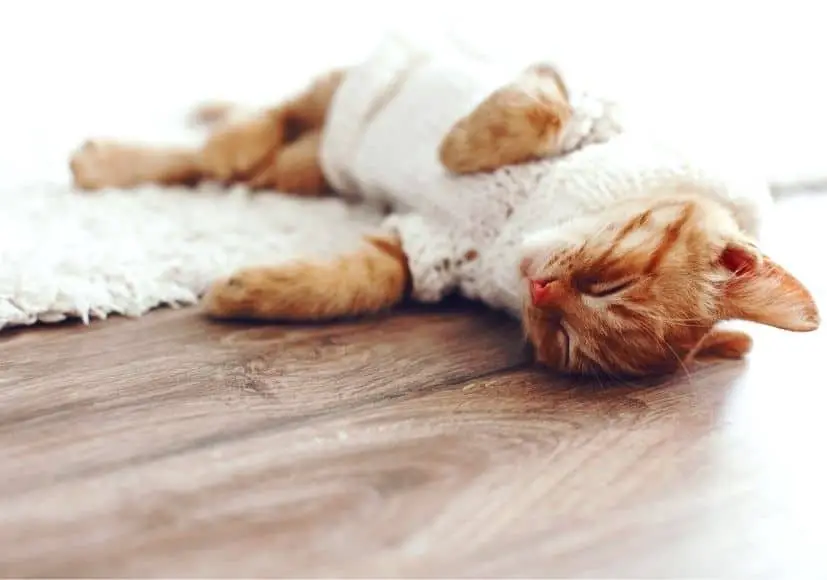Table of Contents
**This page contains affiliate links and I will be compensated if you make a purchase after clicking on my links**
Currently, I have carpet in all my bedrooms. Old, ratty carpet. I’ve been meaning to change the flooring since I moved in… over a decade ago.
I’m also a mom to three fur babies.
I need to choose something that is:
- Resistant to scuffs and scratches
- Easily cleaned
- Best for allergies
- Warm on my bare feet
Spoiler alert: the best floors for pets are, in order, vinyl, laminate, and tile.
Is carpet good flooring for pets?
Carpet is definitely warm on my bare feet. There is nothing worse than getting out of bed on a cool winter morning and standing on the equivalent of ice cubes.
Perhaps you’ve thought ahead and placed a pair of fuzzy slippers by the side of the bed. But odds are one of your fur babies have relocated them. (And left a deposit of slobber…)
This is never an issue with wall-to-wall carpet. Carpet is not only warm, but thanks to the padding installed underneath, it is also soft to walk on.
Another advantage is that it dampens sound. Carpet, plus upholstered furniture, window treatments, pillows, and bedding work together to absorb sound.
This removes that annoying echo. Everything from music, to zoom meetings, sound better.
Also, carpet tends to be less expensive than the other options on this list.
Disposable carpet?
But there’s a very good reason for the moderate price point. While hardwood or tile can last…forever…carpet needs to be replaced on a regular basis.
How often? It depends on the quality grade of the carpet. At the bottom is the unofficially named “renter-grade carpet”. This is the cheapest carpet that landlords install before a new renter moves in. (Or the carpet you quickly install before putting your property on the market…)
Your mileage will vary. The industry standard is carpet that lasts around 10-15 years, but having a pet will drastically reduce this time, perhaps to as little as 3-5 years.
The thickness and quality of the padding underneath will also make a difference. The thicker (and costlier) the pad, the less the carpet will be crushed every time you walk on it, and the longer it will last.
Carpet maintenance and pets
Invest in a high-quality vacuum cleaner. You now have more dirt from outside (dogs), tracked litter (cats), and lots and lots of fur (both).
(My favorite vacuum cleaner is the Dyson Animal. A cordless wonder with enough suction for the most challenging carpet. “Engineered for larger homes with pets.” Indeed, I fill up the dirt trap in just two rooms.)
Pets are an additional cleaning challenge for carpet. Vomit and other “accidents” are common.
Some of these accidents may be hard to pinpoint. Invest in an ultraviolet flashlight. Urine and poop stains will become very apparent. Likewise, vomit residue. And other bodily fluids…
Unfortunately, even “cleaned” carpets may still have residue.
Once you find that urine stain, utilize a cleaner designed for pets. Nature’s Miracle is the standard and is available in several formulations. Most use enzymes designed to break down protein.
To use properly, pour enough on the carpet until it has soaked through.
Although Nature’s Miracle is good, I would not go so far as to call it a “miracle.” Pets have a sense of smell far superior to our own. If a tiny trace of urine or poop remains, they are likely to re-mark the same spot…
For general carpet messes—such as hairballs—my favorite is Spot Shot. This spray-on cleaner “dissolves” stains in seconds.
Carpet is bad for allergies
Allergens are all over the place: dust mites in your bedding, plant pollen from your open widow (or tracked inside). And pet dander.
Carpet will suck up all these allergens like a giant sponge. Sure, vacuuming will help. (Use a vacuum cleaner, like the Dyson, with an onboard HEPA filter.) But vacuuming won’t get it all.
When you walk across your carpet you stir up all these allergens. Allergists agree that carpet is not recommended in bedrooms for those with allergies, and especially asthma.
What about professional steam cleaning? That may help with some of the stains missed by Nature’s Miracle. However, if your carpet remains damp afterward, that promotes the growth of mold. Which many of us are also allergic to.
Carpet yay or nay?
Unfortunately, carpet is low on the list of pet-friendly floors. If funds are tight and you have NO allergies, it’s a consideration.
Keep in mind that you’ll most likely need to change your bedroom floor soon-ish.
This creates its own set of challenges. If I have one piece of advice for new homeowners:
- If your floors need updating, do it BEFORE you move in!!
Once the furniture is in place, and the books and tchotchkes displayed as you like, you are not going to want to pack all that up again.
Sure, the floor installation crew will move your furniture, but it has to fit somewhere temporarily. And again, you’ll be required to pack up and move all the little things.
Bedrooms usually include a full closet of stuff that needs to be packed and moved. Plus, a large mattress and bed frame, that will need to fit somewhere. The latter may need to be disassembled to get it out the door.
Did I mention that I’ve been meaning to remove my bedroom carpet for the last ten plus years?
So no, carpet isn’t a good option if you have pets.
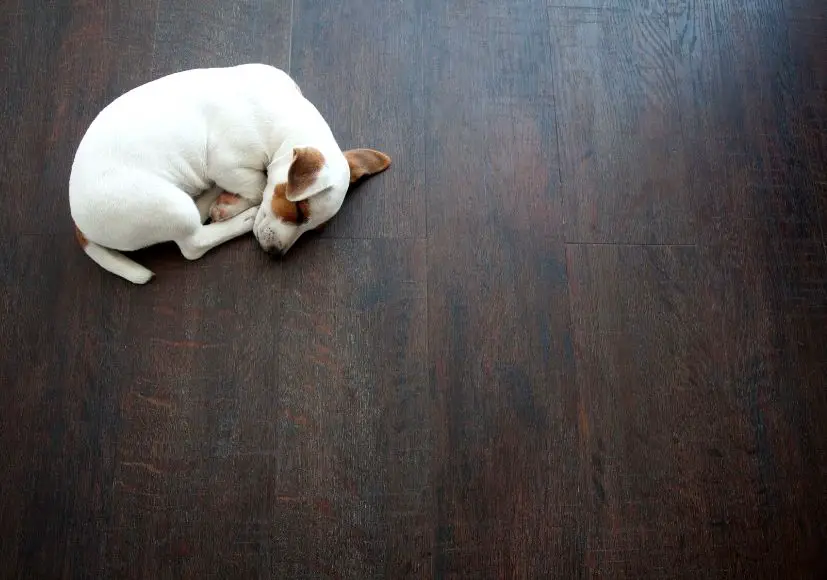
Is hardwood good flooring for pets?
Hardwood is solid wood. Today most hardwood comes ready to install: cut into a tongue and groove pattern to fit together, stained, and finished with a protective polyurethane coating.
Of all the options, hardwood is the most expensive, but also the most long-lasting.
Most of us love the look of hardwood, so it will add to the value of your home. This may or may not help offset its initial cost.
Unfortunately, hardwood needs to be treated with care. Yes, it scuffs and scratches.
Different types of wood have different hardness ratings. The harder the wood, the more resistant to scratches it may be. Hard maple is relatively hard, while black walnut is less hard.
But even the hardest wood can still scratch.
Wood is also susceptible to spills. The protective coating will do its job if the liquid is cleaned up immediately (or the spill is small). But if not, the wood can stain or buckle.
For this reason, no one installs hardwood in a bathroom.
Unfortunately, in many “open concept” homes, for a consistent look, the same flooring is installed in the living room, dining room. And kitchen. Where, unfortunately, hardwood may be at risk of plumbing accidents.
Hardwood maintenance and pets
Hard surfaces, such as hardwood, are the best for those with allergies. Pet fur and other allergens float around and maybe pulled into your HVAC system—where they should be trapped by your furnace filter designed to catch allergens.
Dust bunnies and loose dirt are also easily vacuumed up—minimal suction required. For those who wish to go old school, a dry dust mop will also work.
If you do vacuum, make sure you are NOT using the beater bar intended for carpet, as this could scratch the wood. Either use a soft vacuum head designed for hard surfaces or turn the beater off.
For more intensive cleaning, follow the manufacturers’ instructions. Damp mopping, soaps or liquid detergents are banned, as is steam cleaning.
If your hardwood came with a protective coating, then waxing is not required.
The company that installed my engineered hardwood (see below) has banned me from all cleaners except Bona Hardwood Floor Cleaner, which is designed for polyurethane-finished wood floors.
This cleaner works great for vomit stains and other accidents.
I simply spot clean where needed, but for those of you who prefer a more thorough cleaning, Bona, or similar cleaner may be used to mop your floors
Unlike carpet, the top polyurethane layer should protect wet stains from soaking in. However, if you need something stronger, Nature’s Miracle is indicated for virtually all floor types, including hardwood.
Prevent scratches on hardwood
- Do not slide heavy objects across the floor
- Place felt pads under furniture, especially chairs and other moveable pieces
- Avoid wearing indoors spikey high heels and any shoes with nails in the sole
- Keep your pets’ nails trimmed
Also use rug pads under throw rugs. Avoid lower cost PVC (and similar) pads as they react with the floor’s polyurethane coating over time. Look for pads made of felt, natural rubber, or both.
Despite all your care, scratches will happen
As a pet owner, you may have already accepted that you can’t have nice things.
One advantage of hardwood is that it can be refinished. Have it sanded down, re-stained, and refinished.
Unfortunately, this procedure is akin to replacing your floors. As before, all items and furniture must be removed and stored elsewhere. As the stain and the finish coat(s) need multiple days to dry, this procedure takes longer than installing a new floor.
It’s not as expensive as a new floor, but it may be close…
In other words, not something you wish to do often.
What to do about a cold hard floor
Another disadvantage of all these choices—other than carpet—is that they are cold and hard.
Unlike carpet, you can’t install hardwood over a thick pad. Indeed, you may have installed your floor directly over a cement slab. It doesn’t get any harder than that.
Although not as thick as a carpet pad, consider having your hardwood installed over an underlayment made of either cork or foam. This will add a bit of warmth. For upstairs bedrooms, cork especially, will help block sound, especially footfalls across the ceiling.
If you have the cash, consider underfloor heating. These systems are installed under the solid floor (even carpet) and use either electricity or warmed water to heat the surface above.
It may be more cost effective to install underfloor heating in bathrooms, but for a larger room, such as your bedroom, consider throw rugs.
Enjoy the softness and warmth of carpet, in a size that can be replaced easily.
Most designers would recommend a large rug that fits under the bed and extends out from the edges. Except now you’re back to the same issues as wall-to-wall carpet. (Good luck reaching that hairball under the bed.)
For ease of cleaning (and replacement), consider smaller (less expensive) rugs located in the area(s) where you walk to and from your bed.
And don’t forget your felt rug pad underneath.
Use hardwood in a household of pets only if you don’t mind scratches.
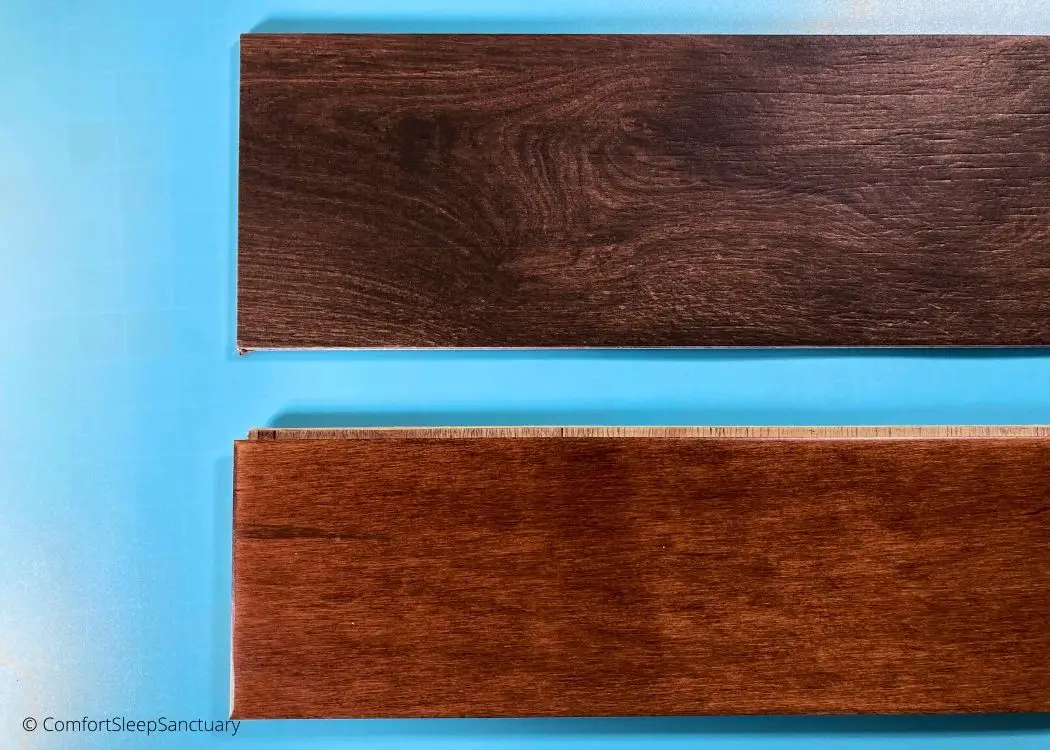
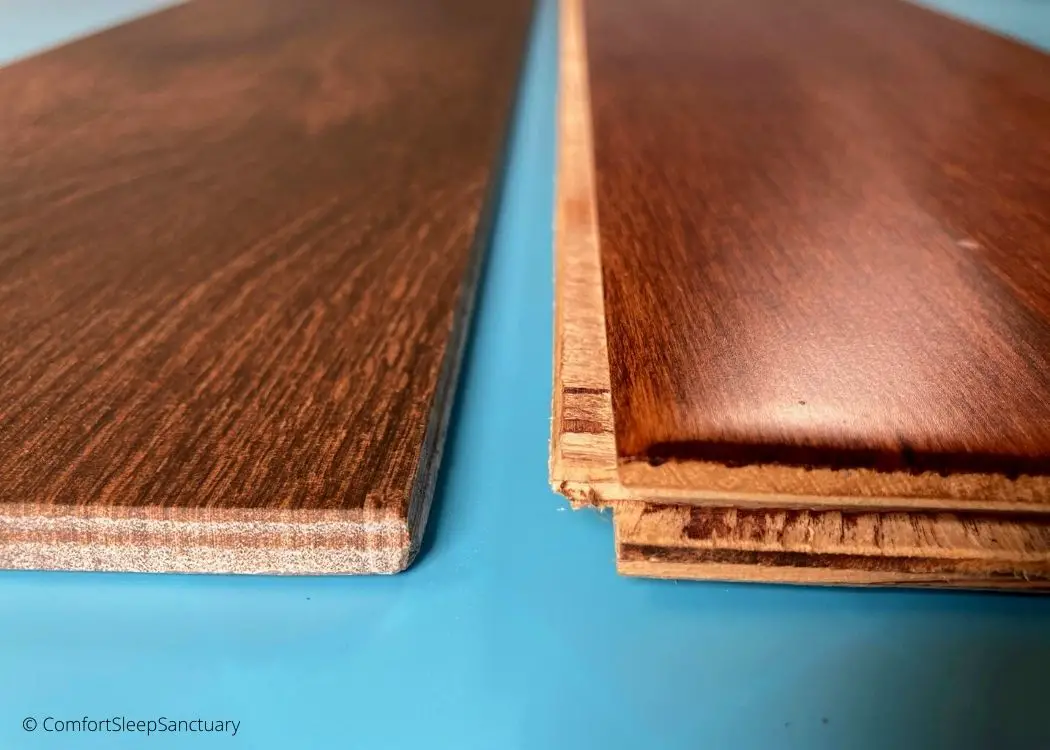
How about engineered hardwood. Is it good flooring for pets?
“Hardwood” floors usually refer to planks of wood that are solid wood, or 100% the same wood throughout. A plank of maple is 100% maple.
If you sand it down and refinish it, there is more maple below.
Engineered hardwood has a thin “veneer” or layer of your wood of choice at the surface, but below is supported by layers of plywood. The plywood layers are applied in different directions for added stability.
Engineered hardwood is far less expensive than traditional hardwood and is also more stable. Whereas hardwood may buckle under damp or humid conditions, engineered hardwood is more likely to maintain its shape.
Once installed, engineered hardwood is indistinguishable from hardwood.
Depending on the thickness of the veneer, you may be able to refinish them once. Twice at most.
Like hardwood, you have the option to install an underlayment or not.
Like hardwood, depending on the softness of the wood used for the veneer, engineered hardwood is also prone to scratches and scuffs.
Clean and maintain engineered hardwood just as you would hardwood.
Again, use engineered hardwood in a household of pets only if you don’t mind scratches.
Laminate flooring. Is it good for pets?
Laminate flooring looks a lot like wood. For the average person high-quality laminate will be indistinguishable from hardwood.
Laminate resembles engineered hardwood in that it also has a base of stable plywood, however instead of a veneer of “real” wood, laminate has a realistic printed picture of wood.
Indeed, if you’re trying to tell if a floor is laminate or wood, look for repeating wood patterns. If you find them, you’re standing on laminate (or vinyl).
When comparing costs, hardwood is the most expensive, followed by engineered hardwood or vinyl, with laminate (or low-cost vinyl) the most cost-effective.
In addition to cost, the biggest advantage of laminate is the quality of the top transparent layer that sits over the picture of wood. This layer is designed to be protective, resisting scuffs, scratches, and general wear.
Laminate is a popular flooring for homes with both kids and pets.
In addition, most laminate is “water-resistant” resisting small spills. Consider investing in a “waterproof” laminate that should resist everything short of a major flood.
The most well-known laminate is made by Pergo (not affiliated), although this company also makes other types of flooring, including engineered hardwood and vinyl. Likewise, other companies make laminate flooring.
But if someone refers to a floor as “Pergo”, then it’s most likely laminate.
Like the other hard surfaces, laminate is good for those with allergies.
To help with sound dampening and wear, underlayment is recommended. Indeed, some laminate comes with its own underlayment attached to each plank.
Although laminate should last for several decades, it does eventually wear. But unlike hardwood, or thick engineered hardwood, it can’t be refinished.
Laminate maintenance and pets
As different laminates have protective layers of varying quality, always refer to the manufacturer’s recommendations.
For most laminate, damp mops and steam cleaning should be avoided, but some manufacturers indicate that their “waterproof” laminate can handle it. (I probably wouldn’t risk it…)
As with hardwood, dust mopping and vacuuming (sans beater bar) are best for day-to-day cleaning.
For their laminate floors, Pergo recommends either household vinegar or ammonia. (But never mix the two!) Floor cleaner indicated for laminate floors is readily available at your grocery store or online.
Because of its reasonable cost and resistance to wear and scratches, laminate floors are a good choice for pet owners.
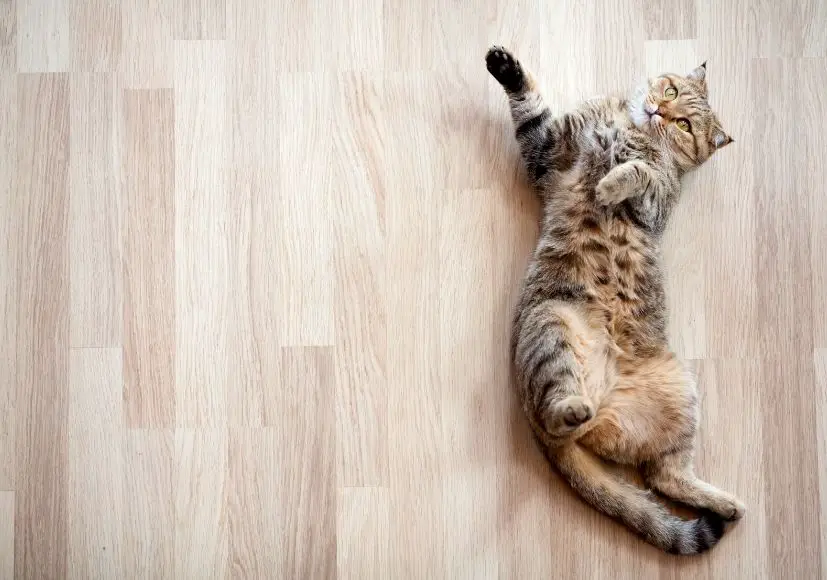
Vinyl flooring. Is it good for pets?
Vinyl flooring may be constructed of planks or squares of vinyl made to resemble either wood or, if you prefer, tile, respectively.
The most common vinyl floor pieces are thin, flexible, and generally referred to as either LVP (“luxury vinyl plank”) or LVT (“luxury vinyl tile”)
In contrast, vinyl planks may be thick and rigid, like laminate, with a core of composite material. EVP (“engineered vinyl plank”) may have a core made of fiberboard, PVC, or stone-plastic (SPC or “stone plastic composite”).
The thick planks are tongue and groove like other wood and wood-like flooring. Thin versions are installed using glue but sometimes are “peel & stick”. (Like regular tiles, vinyl tiles may be grouted to complete the look.)
Alternatively, vinyl flooring may come in large sheets made to resemble wood or tile flooring. Sheets eliminate the gaps between planks but look less like real wood.
High-quality vinyl should be (almost) indistinguishable from real wood.
The advantage is that vinyl is very tough. Thanks in part to a thick urethane coating, it is both scratch-proof and dent-proof.
The latter is important if you tend to drop heavy objects on your floor. Carpet will be fine, but hardwood and laminate may dent. Tile may even crack and break.
Most vinyl is waterproof but note that some brands are only rated “water resistant”.
Indeed, Pergo markets their high-quality rigid vinyl flooring as 100% kid-proof and pet-proof, and includes a lifetime warranty.
(But realistically, most vinyl brands have a limited lifespan like that of laminate flooring, of a few decades. Keep in mind the image is on the surface and could wear down over time.)
Clearly, allergies are not an issue.
Like the other flooring options, underlayment is recommended and may come already attached to each plank.
Quality—and price—varies, but cost should be comparable to laminate flooring at the mid-range, and engineered hardwood at the high end.
As with other flooring options, look for cleaners indicated for vinyl flooring. As above, soap or detergent-based cleaners are not recommended.
Nature’s Miracle should be fine for small messes.
Because of its superior resistance to wear and scratches, vinyl floors are a great choice for pet owners.
Tile flooring. Is it good for pets?
Except for carpet, all flooring options discussed so far are designed to resemble real wood. Tile is no exception, as you can purchase tile with a coating that resembles real wood (see figure above).
However, I don’t think anyone would mistake this tile for the real thing.
Wood-like tile is a ceramic tile, the most common—and cost-effective—type of tile.
However, if you don’t wish to stick with the wood look, tile provides a wide variety of other options and looks. For more money, go with real stone, such as marble, granite, or slate.
Ceramic tile is relatively resistant to scratches and scuffs, although stone tile will vary.
One issue with tile, however, is it is at risk of cracks and breakage. Don’t drop heavy objects on it.
Thicker tile is more resistant to breakage. When tile shopping, note that thinner tile may be intended for wall installations only.
Likewise installing tile on the correct surface is key. An underlayment is again, recommended, especially if sound dampening is an issue.
If you live in earthquake country or are installing tile in a new home that has not yet “settled”, tile is at risk of cracking. If not using an underlayment, tile should be installed on an inflexible surface, such as cement board, or cement. Never install tile directly over wood.
Tile takes a bit longer to install, as adding grout is required. Although ceramic tile is relatively water-resistant, the same can’t be said of grout. For added protection treat the grout with a grout sealer.
Ceramic tile is more or less impervious to any cleaner. You can even dump on bleach if needed.
Stone tile, however, should only be cleaned with pH-neutral cleaners indicated for stone. (Acidic or alkaline cleaners, such as vinegar or ammonia, respectively, can dissolve stone.)
When it comes to pet accidents tile grout can be an issue. Pee can soak in and stay forever. Nature’s Miracle will help, but may not eliminate the odor, and your pet may “mark” the area again.
All-in-all tile makes a good pet-resistant floor.
[phone users, turn your phone sideways for better viewing]
| PROS | CONS | |
|---|---|---|
| Carpet | – Less expensive than hard floors – Wears, but doesn’t scratch or scuff – Warm on bare feet – Dampens sound | – Stains challenging – Short lifespan – BAD for allergies |
| Hardwood | – Long-lasting – Looks good – Adds home value – Can be refinished – Good for allergies | – Expensive – Scratches and scuffs – Susceptible to water damage – Transmits sound & vibration* – Cold & hard |
| Engineered hardwood | – Relatively long-lasting – Looks good, like “real” wood – Good for allergies | – Scratches and scuffs – Susceptible to water damage – Transmits sound & vibration* – Cold & hard |
| Laminate | – Less expensive than hardwood – Resistant to scratches and scuffs – Water-resistant or waterproof – Good for allergies – BEST for PETS | – Transmits sound & vibration* – Cold & hard |
| Vinyl | – Less expensive than hardwood – Scratchproof – Dentproof – Water-resistant or waterproof – Good for allergies – BEST for PETS | – Quality (and price) varies |
| Tile | – Relatively long-lasting – Less expensive – Easy to clean – Resistant to scratches and scuffs – Water-resistant – Good for allergies – BEST for PETS | – Transmits sound & vibration* – Very cold & hard – May crack |
In summary, the best floors for pets include, in order, vinyl, laminate, and tile.
(Top image © photo7180 via Canva.com)
Want to learn more about the products mentioned?
[If you experience issues with menus or links not working, it is most likely due to your Ad blocker.]

